Starting out, I plotted evolution (initial lowercase e), Evolution (initial uppercase E), Darwinism and natural selection. What do you see in the resulting graph?
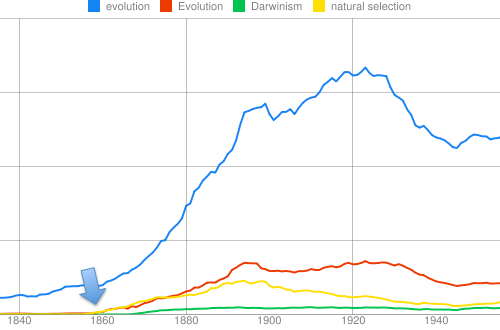
Even though the use of the word evolution predates the 1850's, we see a sharp increase after 1859, the year of publication of On the Origin of Species. Incredible right!? But not surprising. The rise of evolution as a concept becomes clearer when we plot Evolution with an initial uppercase E, as an indication of the use of the word in titles. We also see the emergence of Darwinism and natural selection as concepts after 1859. The impact of Origin really is unmistakable.
So, let's remove evolution (initial lowercase e) to get rid of other uses of the word and see the increase better... and let's add the word genetics.
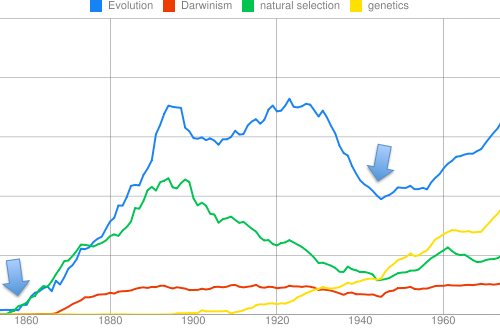
Could the re-discovery of Mendel, the emergence of genetics and the ensuing modern synthesis of evolutionary theory explain the increase in the use of Evolution after the 1940's? I think so! They show a remarkably similar upward trend.
Now, let's plot just Darwinism against creationism to see what we can learn. Darwinism is not a good substitute term for evolution, but it's the one that creationists like to use, so let's go with that to include their own references. Let's also include the demeaning "evolutionism" that creationists also like to use, and of course intelligent design to see what happens.
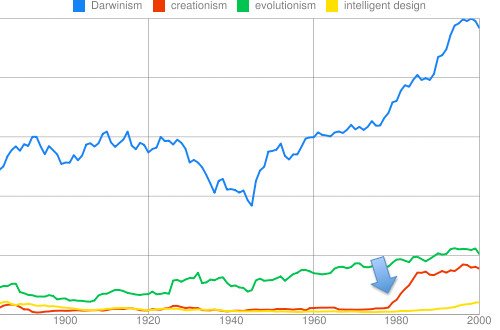
Aside from the obvious conclusion that the creationist terms don't reach even nearly the same impact as Evolution or Darwinism, see that sharp increase in the use of creationism in the 1980's? I really wonder what that could be about. According to the NCSE website the 70's and 80's were the "rise and fall of creation science", so maybe that's what we're seeing? Let's add creation science to the graph and remove Darwinism to plot only the creationist terms.
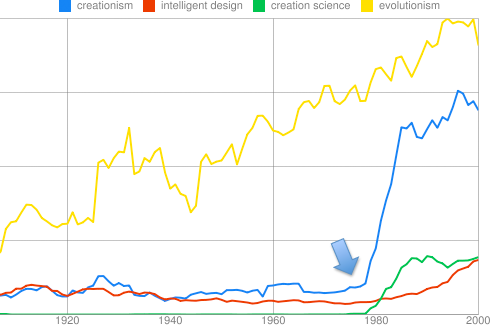
Click here for a bigger view. We see even clearer that the creationist terms also start their upward trend after the publication of Origin! Creation science is an exception, it emerges after 1980 and shows the same kind of increase as creationism in the 1980's, only smaller. The "rise and fall of creation science"? There isn't a similarly sharp increase in the use of intelligent design, but it shows a slow and steady climb over the 80's and 90's, catching up with creation science by the year 2000.
Let's shorten the time-axis focusing on the 80's and 90's and extending it as far as it goes, until 2008. And let's add irreducible complexity, a sneaky term in intelligent design.
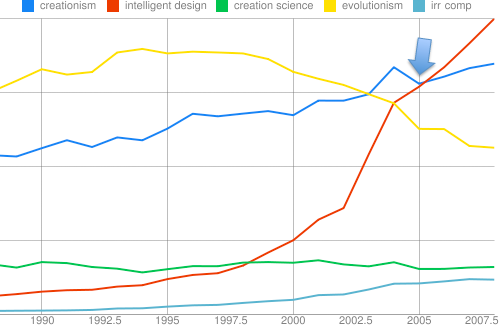
Two things instantly jump out. The book Of Pandas and People published in in 1987 (second edition in 1993) is often seen as the not-so-missing link between old creation science and new intelligent design, and we can definitely see how intelligent design starts taking over during the 90's and how irreducible complexity is on the rise. We also see how intelligent design completely overtakes all other creationist terms by 2005, the year of the famous Kitzmiller vs. Dover trial!
Going back to another big evolution vs. creationism trial, the famous "Scopes monkey trial" in 1925, we see that there was an equivalent, but smaller rise in the use of the term evolutionism.
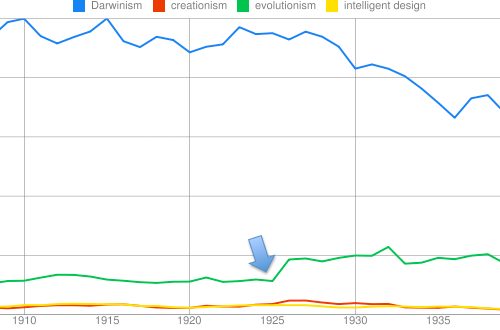
It's incredible what you can see by just visualizing data in a few creative ways. Of course this is a limited analysis, but it's surprising how much you can actually see! Inspired by the always great Information is Beautiful.
No comments:
Post a Comment
Note: Only a member of this blog may post a comment.